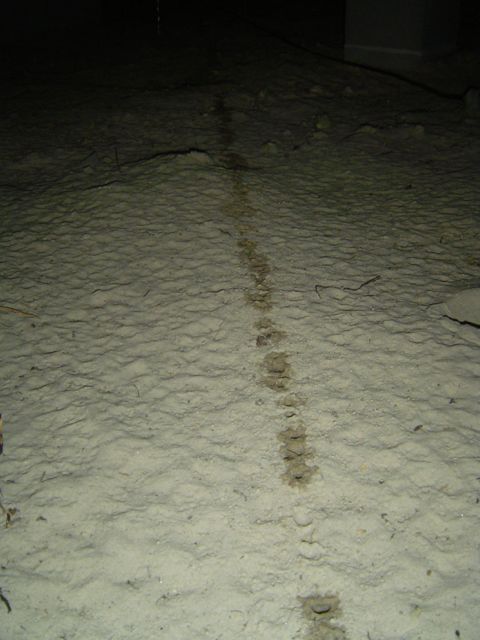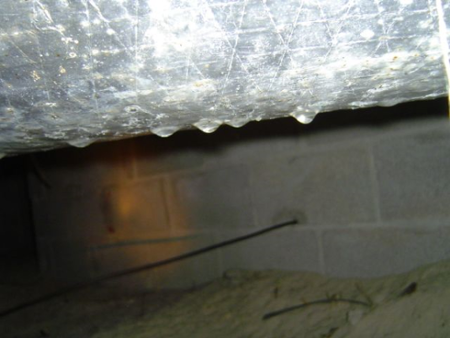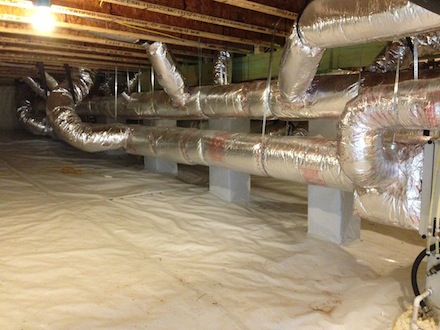A Line in the Sand — The Dew Point Duct Duel

A line in the sand has some significance for Texas, the state where I was born. Colonel William Travis used his sword to draw such a line in the waning days of the Battle of the Alamo. As General Santa Anna had the Texans completely surrounded and asked for their surrender, Colonel Travis asked for all those who would join him in fighting to the death to cross the line and stand with him. As you can see below, homes in hot, humid climates sometimes draw a line in the sand, too.
Who drew that line?
How did it get there? It’s not a snake trail; they don’t travel in straight lines. It’s not a snail trail either; they leave a continuous line of slime. No, it’s pretty clear from the photo that this line in the sand is from drops of water. Is it a plumbing leak? Nope. Not that either.
As it turns out, this line in the sand is from drops of condensation, drip, drip, dripping from the bottom of an air conditioning duct. I took this photo several years ago in Hilton Head, South Carolina. The duct that dripped such a line in the sand is shown below.

The problem here is a duel between the duct and the dew point. As you know, vented crawl spaces and the psychrometric chart are not friends. If you have this problem, it means there’s too much water vapor in the crawl space air for the amount of insulation on the ducts.
It also means you’re wasting energy and may have comfort problems in the home. Every molecule of water vapor that condenses on that duct adds heat. That heat finds its way to the cold air inside the duct. Also, since the duct is underinsulated, the cold air picks up more heat by conduction. The result is that the air getting to the vent in your home won’t be as cold as it should be.
Fixing the problem
The two primary ways to solve the problem are to add more insulation to the ducts or remove some of the water vapor. The latter is best accomplished by encapsulating the crawl space, but in a flood zone, as this home in Hilton Head is, that can be tricky. Find a local pro if you want to consider that option. Of course, you could also rip all the ductwork out and move it up into the conditioned space above, but that can be cost and space prohibitive in an existing home.
The easiest thing to do is to reinsulate. Remove the existing insulation. First seal the ducts thoroughly, though, since cold air leaking into the insulation exacerbates the problem. This may have the added benefit of preventing the sucking and blowing problems I described yesterday. The caveat I mentioned in that article still applies, too. See below.
In a hot, humid climate, the dew point of the outdoor air can get up to 80° F. In a vented crawl space it can go even higher. That means you need to have enough insulation on ducts in that space, assuming you’re not going to encapsulate or move the ducts, to keep the temperature of the outer jacket higher than 80° F.
The ducts in the house shown above had only R-4.2 insulation, and the ducts were leaky. Going with R-8 duct insulation would probably keep the ducts dry most of the time, as long as they’re sealed, too. And don’t forget to seal the outer wrap completely and insulate the boots, too!

But there’s an important caveat: You shouldn’t seal ducts without also measuring—and probably fixing—the air flow in the ducts. Most duct systems are too restrictive. I know some contractors who almost never retrofit an existing duct system. It’s easier and cheaper for them to remove and replace the whole thing than to try to fix the existing duct system.
As Colonel Travis did in that famous battle for Texas, your home also can draw a line in the sand. If it does, are you going to stand with your house and fight? You’ve got building science on your side.
Related Articles
Vented Crawl Spaces and the Psychrometric Chart Are Not Friends
Dew Point — A More Meaningful Measure of Humidity?
The Lesson of the Raining, Dripping, Crying Duct Boots
NOTE: Comments are moderated. Your comment will not appear below until approved.
This Post Has 15 Comments
Comments are closed.

Sometimes condensation occurs
Sometimes condensation occurs inside the insulation wrap, when moist air contacts metal ducts, boots or fittings, as you described in the last of the “Related Articles” links. So it’s important, actually very important, to carefully seal all seams in the insulation jacket to keep moist air from reaching cold metal.
Nobody in their right mind
Nobody in their right mind would or should “re-insulate” ductwork. It is more advantageous and often easier and cheaper to replace the Supply and Return runs with R8 Silver Flex.
As people continue to replace equipment while leaving old ductwork in place, they screw themselves by forcing more, colder, air through the same old, leaky, lesser-insulated ducts causing them to sweat.
If you blow air through a “greater surface area duct”, that is properly sized(bigger), the surface will condense less and on fewer days of the year.
I like the unvented crawlspace approach, and never throwing good money at old ductwork.
David B.:
David B.: Yes, of course. I should have mentioned that and have gone back and added it.
Adam S.: Ah, yes, I should have mentioned that when I first wrote the article. I have friends who say they almost never do a system changeout without also doing a duct changeout for that very reason. See the caveat I added to the end of the article.
I’m curious about the remark
I’m curious about the remark that crawl space dewpoint can actually exceed ambient outdoor dewpoint – that would require sources of both additional heat and humiidity. I can certainly envision a crawl space operating at higher relative humidity than ambient air…a near-certainty much of the day.
Be careful swapping flex for metal. Flex typically needs to be a size or two larger than metal to flow the same air at same pressure drop, and it is awfully easy to screw up flex and further compromise airflow.
I was on a job yesterday where 9″ nominal flex had been rammed through a 7″ wide opening. I’m pretty sure that the framer won’t be the one getting the low-cooling complaint…
The Achilles heel of metal duct is air leaks, but that can be easily fixed in the course of re-insulating it, if it is accessible enough.
Finally, R4 (or R-anything)duct insulation does NOT perform at rated “R” since the air pockets become water pockets.
As to the pictured duct system, how about running a gutter directly beneath the condensing duct, appropriately sloped to daylight and call it a crawl space dehumidifier? By the looks of it, it was condensing many pints per day!
Speaking of throwing money
Speaking of throwing money around; how cost effective is using highly insulated duct in an encapsulated crawl, like the one in the last picture?
Mark Bishton wrote: "
Mark Bishton wrote: “Speaking of throwing money around; how cost effective is using highly insulated duct in an encapsulated crawl, like the one in the last picture?”
Not sure what you mean by “highly” insulated (I don’t think it’s possible to determine the R-value from the picture), but I disagree if you’re suggesting that *any* insulation would be a waste.
Uninsulated supply ducts in an encapsulated crawl or attic will sweat in all but the driest climates. Even ducts in directly conditioned space will sweat if system airflow is on the low side or interior RH is not closely controlled.
Furthermore, notwithstanding the unfortunate moniker ‘conditioned crawl space’, I can’t imagine that insulation wouldn’t be cost effective. It’s not as if you need the crawl to be at room temperature.
David,
David,
I’m not suggesting not insulating ductwork, but just emphasizing that when a good thermal boundary is installed & a crawl is encapsulated, the need for highly insulated duct goes down.
I’ve seen the damage heavily sweating ductwork can wrought.
The question is what to do to prevent sweat. (the air meeting dew point)
The answer is lower the humidity in the space, raise the r-value on the duct or some combo of the two.
The first of those is the most important. If the crawl is encapsulated seasonal weather changes should not have significant effect on its ‘climate’ (temp/rh).
When the ductwork is inside the thermal envelop the necessity of tight joint & insulation is less.
Frankly it should be code that it has to be inside the thermal envelop.
As an aside, I’ve never seen a crawl that was not vulnerable to mice. Using anything but metal ductwork in a crawl is insane. I’ve inspected too many to ever believe differently.
@Mark, nice comment, although
@Mark, nice comment, although I take minor exception with this:
” If the crawl is encapsulated seasonal weather changes should not have significant effect on its ‘climate’ (temp/rh).”
Even if crawl is tight as house, it will still experience several air changes a day. In humid climates, it’s unrealistic to expect crawl dew point to be in line with house, at least not without mechanical dehumidification, which is would be expensive, and unnecessary.
In any case, if crawl is closed, a minimal insulation wrap (R-4) should prevent condensation as long as all seams are sealed.
I totally agree with your comment that code should require ducts to be inside the envelope, and regarding mice.
For a 1500 sq.ft., 48″
For a 1500 sq.ft., 48″ bottom to subfloor, encapsulated crawlspace in central NC (new construction in 2010) we used a 4″ supply duct off the plenum (with a cape backdraft damper) coupled with a small (30-pint) dehumidifier set at 65% RH. It would run intermittently mostly during the cooling season. The crawlspace was encapsulated with a 10mil fire-retardant poly barrier with a 0.03 perm (US) rating.
Question: should we continue with this strategy?
Cons:
the small dehumidifier was recalled by the manufacturer about 3 years into its life. We are having second thoughts about putting another one in and dealing with potential recalls or failures, or worse yet, risks associated with an electrical appliance in the crawl.
Pros:
As nice and comfy this crawlspace might seem to be, I am not crazy about recirculating air between it and the house so the supply-only strategy works better for me – keeping the crawl under slightly positive pressure and counting on air exfiltration to the exterior. Btw, house is balanced with an ERV.
Without the small dehumidifier the RH creeps up to 70-75% region and I am not comfortable leaving it like that in the long term.
One practical solution: install a pex-based residential sprinkler right in the vicinity of the dehumidifier (a 3/4″ water supply line is nearby). Very simple to install. Am I a bit crazy?
SZMIKWICS,
SZMIKWICS,
Is your standard foundation waterproofing strategy a corrugated pipe laying flat on top of the footing?
@Paul S, if your crawl RH
@Paul S, if your crawl RH climbs to 75% without mechanical dehumidification, you still have a moisture source. Stop the source and you won’t have to throw good money after bad by purchasing another DH, not to mention the ongoing electrical cost to operate it.
If there’s bulk moisture below the poly, you have a site/footing/roof drainage issue (or a high water table). Either way, your crawl (apparently) isn’t sealed very well. I suggest you hire a technician to depressurize the crawl with a blower door. Aided by a smoke pencil, s/he should be able to identify the primary leakage paths.
“Even if crawl is
“Even if crawl is tight as house, it will still experience several air changes a day.”
David, if the crawl is tight how does it get several air changes a day without wind to drive the pressure differential to a significant number?
“if your crawl RH climbs to 75% without mechanical dehumidification, you still have a moisture source.”
David, there is always a moisture source, the ground & masonry under & behind the barrier. If RH climbs there is a path or paths between the source & the crawl.
Seems logical that depressurizing the crawl would displace & distort the barrier causing damage to it. Please explain how you would do that.
On one hand you said previously that “In humid climates, it’s unrealistic to expect crawl dew point to be in line with house, at least not without mechanical dehumidification, which is would be expensive, and unnecessary.”
Now you are say, “Stop the source and you won’t have to throw good money after bad by purchasing another DH, not to mention the ongoing electrical cost to operate it.”
Are you saying that the tightness concern is more between the crawl & the exterior, than the crawl & the underlying ground moisture?
Mark wrote: “if the
Mark wrote: “if the crawl is tight how does it get several air changes a day without wind to drive the pressure differential to a significant number?”
Air changes are driven not only by wind (which is always a factor over time) but mostly by stack effect. A well-sealed house might have an average natural air change rate of, say, 0.10 ACH-nat (verified by a blower door), which means an average of one change every 10 hours over the course of a year. Sometimes more, sometimes less.
Addressing site/footings/roof drainage issues will minimize hydrostatic pressure that otherwise would overwhelm even the smallest imperfections in the moisture/air barrier (primarily from the ground and below-grade walls).
“depressurizing the crawl would displace & distort the barrier causing damage to it.”
In order to effectively use a smoke pencil to find leakage paths, it’s necessary to use blower door in depressurization mode. It’s true this can lift lighter weight floor barriers if there are leakage path from below. I’ve seen it happen. But this doesn’t necessarily cause damage. It’s up to the technician to adjust the pressure accordingly to prevent damage. A company I used to work for used 20 mil, which doesn’t lift very easily, and holds up much better to foot traffic (e.g., hvac or plumbing service techs).
“Are you saying that the tightness concern is more between the crawl & the exterior, than the crawl & the underlying ground moisture?”
No, both are equally important. I see no conflict between the two statements you quoted. The idea of a closed crawl is to first minimize bulk water loads (from foundation and ground) as well as minimize infiltration loads (through walls and rim band) so mechanical dehumidification isn’t necessary. As long as the crawl stays below about 65%, there’s no risk to the structure. The house needs to be lower than for comfort reasons.
Putting a small amount of supply air in the crawl is a defensive measure, and may be sufficient to resolve (minor) elevated RH levels.
Air at 50-60% RH that wanders
Air at 50-60% RH that wanders into a cooler crawl space may well exhibit 75% RH.
A reasonably careful blower door depressurization for leak location shouldn’t damage a 10 mil barrier. Nowhere is is said that the depressurizatio need to be to -50 PA (or any other specific pressure)
Curt wrote: “Air at 50
Curt wrote: “Air at 50-60% RH that wanders into a cooler crawl space may well exhibit 75% RH.”
Point taken, but if crawl is sealed and insulated, it won’t often be cooler than house during periods when house RH is that high. Although I can see this happening in swing seasons, when you can have extended periods of wet cool weather with relatively high dew points. Not coincidentally, this is when not-so-tight homes are most likely to need supplemental dehumidification, and is the strongest argument for making envelope tighter in moderate and hot humid climates.